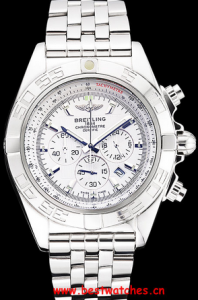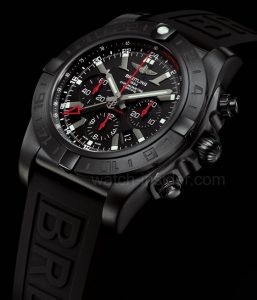Two chronographs robed in black and powered by in-house movements — the Breitling Replica Watches of the Moon and Breitling Chronomat GMT Blacksteel go head to head in this comparative test. Black cases are all the rage. So are in-house chronograph movements. Omega and Breitling combine both in two new watches that here go head to head: the Speedmaster Dark Side of the Moon, from Omega, and Breitling’s Chronomat GMT Blacksteel. The Breitling Chronomat was introduced in the 1940s, but the watch’s styling has been continually updated. The Chronomat GMT Blacksteel has a martial look to it: the gigantic, dark, matte-finished, 47-mm case is more than 18 mm thick; the screwed push-pieces and the rotating bezel, with its four applied cursors, look extremely sturdy. The watch weighs a hefty 209 grams. When you wear the Blacksteel, you almost feel as though you belong to a special-ops task force. The steel of the case is called “black,” but it really looks more like dark anthracite. The Breitling Swiss Replica DLC coating is relatively scratch-resistant, but it is thin, and harsh treatment can leave silver-colored scratches on it.
The Best Replica Breitling has an illustrious and often-told history: unveiled in 1957, it was chosen for NASA’s manned spaceflight program in the 1960s. The high point of the watch’s space career came in 1969, when Buzz Aldrin wore this model over the sleeve of his spacesuit while strolling across the lunar surface. This new rendition of the Breitling Replica Bentley Watches is more elegant than other versions thanks to its black case and dial, both made of zirconium dioxide ceramic. The white-gold hands and the applied white-gold indexes, which are coated with Super-LumiNova, look more luxurious than the white hands and applied luminous indexes on other Breitling Replica Watches Reviews. The black bezel and its tachymeter scale don’t contrast very strongly with the black case. Chrome nitride, which forms an uncommonly hard and very adherent coating, is used for the silver-gray lettering that’s inset along the ceramic bezel.
Tag: Breitling Chronomat Replica Watches
Breitling Chronomat Replica Watches

Name:Breitling Chronomat Replica Watches White Dial Stainless Steel Case And Bracelet 622223
Movement: Quartz (Battery)
Quality: Japanese Miyota
Case: Polished stainless steel case
Back: Polished stainless steel snap-in back with Breitling engraving
Bezel: Polished stainless steel bezel with Arabic numeral minute markers
Crown: Large polished stainless steel cutwork crown with a round push-button crown on either side of it
Bracelet: Polished stainless steel link bracelet with logo and Breitling 1884 engraved polished stainless steel push-release clasp
Band Type: Stainless Steel
Sales of Breitling Chronomat Replica Watches declined markedly during the second half of the 1960s. Breitling and its competitor Heuer formed a partnership to develop the first automatic Breitling Chronomat Replica Watches and hoped that its launch would help counteract the downturn. The adventure began in 1965, when the two firms, along with Büren Watch and Dubois Dépraz, signed a contract to develop the watch; they called the venture Project 99. Büren was taken on as movement supplier because of its experience with micro-rotors. No other type of self-winding caliber could permit the rearward and thus service-friendly installation of the specially developed chronograph module because the small oscillating weight didn’t interfere with the two arbors of the elapsed-time counters. Furthermore, the date ring was positioned directly under the dial. Modular architecture also made it possible to install the crown on the left side, where it clearly showed that this was a self-winding watch. Breitling Replica Watches and Heuer (now TAG Heuer) were responsible for the design, the dials, the cases and the other components. The first prototypes of Caliber 11, which ran at 19,800 vph, were available in the spring of 1968. The official launch of the Breitling Chronomat Replica Watches, the world’s first automatic chronograph with micro-rotor, took place simultaneously in Geneva and New York on March 3, 1969. When the curtains rose, the project had already consumed about half a million Swiss francs.
